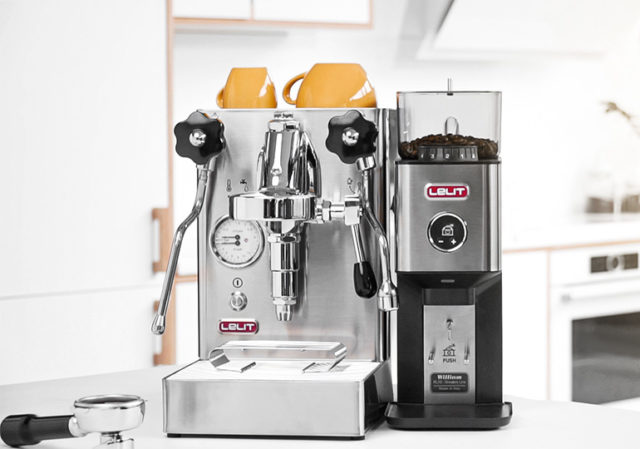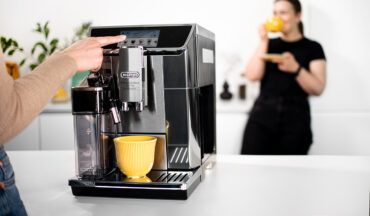The world that we live in differs radically from the world that our parents inhabited. We’re surrounded by self-driving cars, mobile phones with built-in calculators (remember your math teacher not letting you use your calculator at school because “you won’t be able to carry it around with you everywhere you go”?..) and, of course, delicious coffee that can be accessed quickly and easily.
It may seem like most technologies have developed completely naturally and that there’s no one person or thing we can thank for the lives we lead today. However, when it comes to high-quality coffee that is so easy to access nowadays, as well as the growing popularity of domestic espresso machines, there’s definitely a single catalyst that all of us should acknowledge. It’s the movement called “the third coffee wave”.
The Third Coffee Wave

The third coffee wave is the name given to a movement that started in 2000. Around that time, more and more specialised cafés started springing up — in them, coffee brewing was considered to be a craft, and over time, it evolved into a true art and a unique science. Baristas and café owners kept raising the standards applied not only to the brewing of coffee itself, but also to the coffee beans used for the preparation of drinks. This led to the development of numerous microlots (small coffee farms). Instead of selling their exceptional coffees to bigger cooperatives, farmers started selling their precious beans directly to specialised cafés.
Eventually, we — the clients of those cafés — were affected by these changes too. We stopped drinking regular old Italian espressos and began searching for something much more extraordinary and outstanding. Little by little, we pushed the bitterness typically associated with coffee to the back of our minds and instead gave the natural bitter sweetness of arabica beans a chance — we found out that in the right hands, unusual coffee flavours can gloriously unfurl on our palette and turn into a gorgeous blossom of taste.
As time went on, the curiosity of coffee lovers only grew. While searching for new flavours and coffee varieties, we visited numerous cafés offering exceptional coffee drinks: this not only taught us to take an active interest in and bravely explore the realm of coffee, but it also awakened the creative instinct dozing inside of us.
Home-Brewed Espresso

Once we were done tasting the drinks that cafés were offering us, we started thinking that perhaps we should try and brew coffee ourselves. To turn this idea into reality, the manufacturers of espresso machines had to take their appliances further than they had ever taken them before. Thankfully, they took up the challenge: bulky coffee brewing instruments found in cafés were magically turned into compact machines that could adorn any interior and still possessed the same functions that bigger appliances boasted. Having created domestic espresso machines, these people allowed us to get creative too. It has to be said though that in order to foster this kind of creativity, knowledge and skills are needed: only the latter two can help us tame these wild coffee-brewing animals and take full advantage of the possibilities offered by them.
Semi-automatic coffee machines are based on the simple principle of cause and effect. This means that the more effort you put into learning how to brew the most delicious coffee, the higher the quality of the prepared drinks will be. A significant part of this learning process consists of pure theory. You can discover everything you need to know about grinding your coffee, selecting the correct water temperature and dispensing the drink in the right way simply by reading the relevant sections of the user manual.
Unfortunately, other subtleties involved in the operation of a semi-automatic coffee machine require a lengthy process of trial and error. You might have to tamp your coffee and froth milk hundreds of times before you do it right. Although this might sound a bit like torture, the final result is definitely worth fighting for — it involves coffee that’s no less than perfect, brewed by nobody else but you! Once you’ve nailed every step of this process, we can guarantee you’ll never want to go to a café again. Why would you? After all, the most delicious coffee you’ve ever tasted is waiting for you at home!
The Perfect Flavour of Espresso

Discovering the best beans and mastering the recipe that suits them perfectly will allow you to enjoy the ideal espresso. Rich crema characterised by the pattern of tiger stripes, letting everybody know that the drink has been brewed to absolute perfection. Under it, a full-bodied, syrupy espresso, the smell of which alone is guaranteed to shake you out of your sleep. And then, of course, there’s that magical first sip, providing you with a feeling of pure pleasure. This is the kind of coffee all of us dream about — and a semi-automatic coffee machine can help you brew it.
Espresso Machine: What Should You Pay Attention to?
If you’ve ever been to a café and had a barista prepare you a cup of coffee using a coffee machine, the appliance has most likely been semi-automatic. Its very name suggests that part of the work involved in the brewing of coffee is performed by the machine, while the rest depends on you. You probably won’t have to look too deeply into the insides of your coffee machine when making drinks, but knowledge about the various components of your appliance and the functions that they perform might still come in handy. Furthermore, if you’re in the process of searching for the best semi-automatic coffee machine for your home, knowing which technical characteristics are worth paying attention to can definitely help you make the right choice.
Water Tank or Direct Connection to the Mains Water Supply

Most domestic espresso machines are equipped with a removable water tank that can be filled up manually. A couple of things are worth considering here: first, the tank must be convenient to remove and fill up. Second, the capacity of the tank must match the number of drinks you’re planning to brew daily. The latter is a question of convenience and hygiene: if you only brew several cups a day and your tank is extremely large, the water may become “stale” after a while. However, if you prepare lots of espressos and lattes using a water tank that is extremely small, you’ll have to fill the tank up multiple times each day.
Instead of being equipped with a water tank, some espresso machines can be plumbed in, that is, connected directly to the mains water supply. This is particularly convenient as you don’t have to worry about filling the tank up. Nevertheless, a plumbed-in coffee machine loses part of its mobility: its location in your kitchen will be decided by this connection. Moreover, such espresso machines are usually more expensive and they also take up more space.
Heating Systems of Espresso Machine

Instead of using regular water when brewing coffee, we use water that’s been heated up to a certain temperature. Keep in mind that water is one of the key ingredients of any coffee drink. The quality of your espresso necessarily depends on the temperature of the water used to brew it, as well as on how consistent this temperature is.
When it comes to the heating systems found in espresso machines, they’re divided into four types: your appliance might have a heating element (thermoblock), it might have a single boiler, it might be equipped with a heat exchanger (HX) or it might be a dual-boiler espresso machine. Now, how are these systems different from one another?
Espresso machine with a thermoblock or thermocoil heating system
This instantaneous heating system is found in entry-level espresso machines. Water is heated once the coffee brewing button has been pressed. The biggest advantage of this system: hot water is ready instantaneously and there’s no need for you to wait for it to heat up. The biggest disadvantage: this kind of system isn’t capable of ensuring consistent water temperature, so the quality of espresso might suffer a bit (you’ll only be able to notice these nuances of flavour if you’re a true espresso connoisseur though). In addition, you won’t be able to dispense coffee and steam at the same time: these actions will have to be performed one after the other.
It’s also worth noting that the thermoblock system is usually encountered in cheaper coffee machines. The thermocoil system is more innovative: it’s particularly durable, quick and capable of maintaining stable water temperature.
Espresso machine with a single boiler
Some espresso machines are equipped with a single boiler that is used to heat water. Unlike the thermoblock/thermocoil systems, this one provides constant heating of a certain amount of water (the amount depends on the size of the boiler). The biggest advantage: stable water temperature. The biggest disadvantage: depending on the size of the boiler, you might have to wait for the water to be ready — this might take anywhere from 3–5 to 20–30 minutes. As a result, you should definitely consider the size of the boiler and choose a single-boiler espresso machine based on the number of coffee portions you’re going to brew each day.
Another important aspect that must be taken into account is the fact that this boiler heats water used to produce coffee, steam and regular hot water. This means that you won’t be able to dispense steam and coffee at the same time. After brewing a cup of coffee, you’ll also have to wait a bit before dispensing steam (the water used to produce steam must reach the required temperature — otherwise, the steam might not be dispensed properly). The same applies to brewing coffee after you’ve just dispensed steam: you’ll most likely have to wait a bit for the water to cool down and reach the temperature that is used when preparing coffee (90–95 °C).
If you tend to drink espresso only or plan on using your coffee machine to make a couple of milk-based drinks each day, this type of appliance will be the perfect fit for you!
Espresso machine with a heat exchanger (HX machines)
These machines are also equipped with a single boiler, but it’s used to dispense steam and hot water. There’s a special tube passing through the boiler — cold water flows through this tube. This water is used to brew coffee and is heated separately until it reaches the temperature required for the preparation of espresso.
The biggest advantage of such coffee machines: these appliances are almost twice as cheap as dual-boiler models, yet they’re still capable of dispensing both steam and coffee simultaneously. They’ll also help you save energy. Moreover, the tube used to prepare coffee draws water from the water tank or the mains water supply rather than getting it straight from the boiler, so the water is guaranteed to be fresh at all times.
Compared to the appliances falling under the upcoming category, the main disadvantage of HX models lies in the fact that the users have no direct control over water temperature — the temperature of the water inside the tube depends on the temperature inside the boiler. Also, prior to brewing coffee, a cooling flush must be performed. Nevertheless, HX systems keep advancing, so the latest HX machines, such as the famous Lelit “MaraX PL62X”, don’t require these flushes anymore.
Dual-boiler espresso machine
These appliances are equipped with two separate boilers: one of them is used to brew coffee and maintains a lower water temperature, while the other one is used to produce steam and maintains a higher temperature. Because the process of milk frothing has no influence on the other processes taking place inside such machines, dual-boiler appliances manage to constantly maintain the temperature required both for the production of steam and the brewing of coffee. This also means that coffee and steam can be dispensed simultaneously.
It must be mentioned that these machines are likely to take up more space, use up more energy (this is because they must constantly keep the water inside both boilers hot) and cost a bit more. The perfect espresso is definitely worth it though!
Coffee Brewing Group Heads

Another important element of a semi-automatic coffee machine is its group head. Because coffee flows through this part of the appliance, the manufacturers of coffee machines are paying special attention to perfecting it as much as possible. The main task of group heads found in semi-automatic coffee machines is to let water flow through them without losing or changing the pressure, while maintaining the required temperature and ensuring that the water infuses the tampered coffee in just the right way. The two types of group heads — the standard (ring-shaped) and the classic E61 ones — have their own unique advantages and disadvantages.
The first type is characterised by automated operation — in order to start or stop the dispensing of water, all you’ll have to do is press a button. The rest of the process will be performed according to the settings selected in advance. If you’re looking for a coffee machine that would stick to the same settings and would automatically follow the same steps each time you brew coffee, a standard group head is definitely the right one for you.
The classic E61 group head is operated with the help of a lever. In order to start, pause or stop the dispensing of water, as well as dampen the coffee, you’ll have to change the position of the lever. These positions are not pre-programmed, so they operate on a manual basis. While this kind of group head doesn’t ensure the same level of stability that the standard group head guarantees, it allows you to adjust certain settings in real time. This means that you’ll always be ready to adapt to changing conditions, which is particularly important to those who have mastered the coffee brewing process. The E61 group head also ensures thermal stability, so this aspect of your coffee will stay more or less uniform all the time.
Portafilters

A portafilter is also a key component of an espresso machine. This is where coffee is tamped before inserting the portafilter into the group head. There are portafilters of various sizes, yet the standard diameter found in the simplest, entry-level machines is 50–53 mm. These portafilters hold less coffee, so in order to increase the pressure, there’s a layer with a single hole in it under the mesh. This type of portafilter is called “pressurised”.
The portafilters found in semi-automatic machines of a higher class are usually characterised by a larger diameter (57 or 58 mm). They hold more coffee, so there’s no need to create additional pressure by changing the mesh. These portafilters are known as “non-pressurised”. Although the difference between 57-mm and 58-mm portafilters is really small, the latter diameter is considered to be the standard in professional espresso machines.
Portafilters can also be single or double. A single portafilter has one spout, which is used to release the prepared drink. It holds less coffee, the overall area through which coffee is pressed is small in comparison, and its edges are slanted. Even though single portafilters are quite great when it comes to preparing a smaller portion of coffee, they’re not really practical and they can be damaging to the coffee brewing process.
A double portafilter is equipped with two spouts, all of its surface area is dedicated to releasing the drink, and this surface is even, so the flavour is extracted in just the right way, taking advantage of every bit of coffee poured into the basket. Because of their shape, double portafilters found in some semi-automatic coffee machines can be used to brew drinks using coffee pods, as well as ground coffee.
All of the other components of a portafilter, such as the material its handle is made of, as well as its colour, don’t really influence the final result of the process of coffee brewing. The material and the colour you end up choosing depend solely on your personal preference. Some people think that a slanted handle is at times a better choice because it allows the user to place the portafilter evenly on the working surface. However, this doesn’t make that much of a difference either: when tamping coffee, you’ll most likely rest the portafilter against the edge of the table or place it in a special holder — otherwise, you’ll risk ruining the surface.
If you want to enhance the quality of your drinks and make the coffee brewing process more convenient, we recommend focusing on finding a heavy tamper that is comfortable to grip. Tamping your coffee correctly is crucial if you want to enjoy delicious drinks. Remember that a high-quality tamper is much more than a sign of good taste!
Steamer of Espresso Machine

A steamer is an absolute must in any espresso machine. We’ve already discussed the aspect of steam that relates to water temperature: if this temperature is too low, the steam won’t be dispensed properly. Keep in mind though that the shape of the steamer, its coating and the number of holes found in it are all no less than important.
The steamers found in entry-level coffee machines look like regular tubes. They work great when you need to heat and froth milk foam, but when it comes to making latte art, they’re just not suited for it.
As you go up the different coffee machine categories — from the entry-level to the premium-class ones — you’ll find that the steamer is becoming ever more subtle, as well as narrower. On the bottom of regular steamers, there’s a single minuscule hole. In addition to preparing gorgeous cappuccino, a steamer like that is capable of producing high-quality latte.
The steamers found in premium-class models can have two, three or sometimes even four holes. They allow you to create that classic whirlwind motion that professional baristas love so much. Such steamers are shaped in a way that lets them be immersed in the milk with ease and causes the liquid to start turning as soon as the holes touch the surface of the milk. Premium-class steamers are often made of double-layered metal, so they protect you from burns and are convenient to operate manually.
We must point out though that regardless of the shape, power and other aspects of your steamer, it’ll still take some practice for you to learn how to use it properly. Once you’ve mastered this technique, however, not only will you be able to prepare light, naturally sweet milk foam, but you’ll also have a chance to give latte art a try and unleash your creativity by using the foam to paint on your coffee!
In some coffee machines, the steamer also functions as a hot water nozzle. However, if you’re planning on using the hot water function for the preparation of tea quite often, or if you’re a fan of the americano recipe, we recommend choosing a machine with a separate hot water spout. You’ll find it a lot more convenient.
Pressure Gauge of Espresso Machine

For those of you who value precision and want to brew coffee according to the highest of standards, a pressure gauge, also called a manometer, is definitely a crucial tool. It allows coffee lovers to monitor the pressure used when preparing drinks. For true espresso, pressure of 9 bar should be used. If your espresso machine isn’t equipped with a separate lever for the adjustment of brewing pressure, you’ll only be able to adjust it by changing the portion size or the grind level of your coffee. In order to change both of them though, you’ll need to use a coffee grinder and not the machine itself.
Espresso Machine With a Built-in Grinder or Without One?

A coffee grinder — whether built-in or separate — is an indispensable part of the process of brewing coffee in a semi-automatic coffee machine. Using beans that haven’t been ground just moments ago in such an appliance would truly be a crime against the perfect espresso!
A built-in grinder is a wonderful solution for those who are on a budget and don’t have a lot of space for a coffee machine in their kitchen, yet still want to enjoy delicious, high-quality drinks. As far as its features are concerned, a coffee grinder of this type doesn’t differ much from a separate grinder. However, the first one is located inside the coffee machine, which means that as the appliance heats up, it heats the beans as well — and this might have a negative impact on the flavour of those beans.
A separate coffee grinder eliminates this risk completely. Moreover, going for a separate grinder means you’re free to choose a model that you truly like. But what should you consider when choosing the right grinder for you? The most important element is definitely the burrs. They can be conical or flat, as well as ceramic or made of steel. Premium-class espresso machines tend to be equipped with flat burrs because they ground coffee more evenly — nonetheless, they can still be made of steel or they can be ceramic. So, which ones are better? There’s no one right answer here. Steel burrs are sharper, so they’re capable of grinding coffee with more precision, but once they become blunt, they lose this quality — which means that you must then disassemble the grinder and sharpen the burrs.
On the other hand, while ceramic burrs might lack precision at times, they pretty much never become blunt, so burrs of this kind last much longer. All in all, the question you must answer when choosing the right coffee grinder for you is this: would you rather enjoy the perfect taste and spend some extra time maintaining the burrs of your grinder, or would you rather save some time spent on maintaining the burrs, yet sacrifice a few nuances of flavour as a result? Of course, this is only relevant if you tend to go for coffee beans of the highest quality. If the beans are only average, you’re unlikely to feel any difference in their taste, regardless of the burrs you pick.
Coffee Brewing Settings for an Even Higher Level of Mastery
If you purchase an espresso machine equipped with all of the components listed above, it’s guaranteed to help you out in your pursuit of the perfect coffee. Nevertheless, it’s also helpful to find out more about a few important settings and functions that can be found in these machines and that can definitely raise your drinks to a whole new level, as well as provide you with coffee-drinking experiences that are impossible to forget.
Temperature of the Water Used for Brewing Coffee

Even entry-level semi-automatic coffee machines allow users to adjust water temperature, but in their case, only different levels are provided: that is, the users can choose between “low”, “medium” and “high” temperatures. In models of a higher class, specific numbers are shown and the users are able to choose the exact temperature themselves.
Water temperature is extremely important for the preparation of high-quality coffee: water that is too hot can end up destroying the unique flavour characteristics of the beans, while water that is too cold may fail to unveil all of those valuable features. A temperature between 90 and 96 °C works best. Adjusting the brewing temperature within these limits can help you reveal certain notes in your coffee. The closer it is to 90 °C, the sweeter and more acidic the resulting drink will be. The closer it gets to 96 °C, the more bitter the beverage will become. If you know your coffee beans like the back of your hand and are absolutely certain that specific notes will make them taste even better, the possibility to select the exact brewing temperature can definitely be useful. It also allows you to experiment and keep discovering new flavours every time you brew a cup! One or two degrees here or there, and the final result will be radically different.
Pre-Brew Function

One of the most advanced technological solutions found in semi-automatic coffee machines is the so-called pre-brew, or pre-infusion, function. Thanks to this feature, the coffee in the portafilter is dampened evenly using low water pressure. This ensures that once the water is released in full force, it’ll infuse every bit of the ground coffee, instead of reaching a small part of it only. So, quite naturally, pre-brewing has a decisive impact on the aroma and taste of the prepared coffee.
Some coffee machines are equipped with a built-in pre-brew function that cannot be adjusted, while others (like the ones with the E61 group, for example) allow users to control it manually. Premium-class appliances even enable you to control this function electronically, via a convenient display. If you want to find out more about pre-brewing, additional information is provided in a separate section of the upcoming chapter titled “Brewing Coffee in a Semi-Automatic Coffee Machine”.
Adjustable Water Quantity

If you want to prepare delicious coffee, the right water temperature alone won’t suffice. The amount of water has just as much influence on the flavour of the prepared drink. In semi-automatic coffee machines, water quantity can be either programmable or adjusted manually.
When it comes to the portion size of regular black coffee, there are no strict rules — your personal taste is what matters most here. Simply experiment with different quantities and give several variations a try. The one that you find to be the tastiest will automatically become the right one!
As far as the brewing of the true espresso is concerned, however, this drink is much more demanding. There are certain rules that you have to abide by if you want to obtain the best possible flavour. Start dispensing the drink and then stop it right before the white foam starts flowing. Once a small light spot appears on the dark espresso crema, take it as a sign that this is the exact water quantity that you should select for the preparation of espresso. If you’re using an espresso machine with the E61 group head, you’ll have to stop dispensing coffee at this exact moment each time.
Conclusions
To summarise all of the subtleties leading us towards the perfect cup of coffee, we can definitely state that in the end, it all depends on your willingness to learn and perfect the skills that you acquire along the way. If this is missing, even the most technologically advanced machine will be quite useless. So before we move on to discussing the best espresso machine models currently on the market, we’ll reveal to you step by step how to master the coffee brewing process and, as a result, cheer up both yourself and every guest who enters your house with a cup of restaurant-style coffee!
Brewing Coffee in a Semi-Automatic Coffee Machine
Choosing the Best Coffee Beans for Espresso and Black Coffee

Let’s start with choosing the right coffee beans. If you’re going to make espresso or black coffee, any beans roasted specially for the espresso brewing method will work just fine. The brewing method is usually indicated on the packaging of the beans or in the coffee description. If there’s a word “espresso” on the packaging, it means that the coffee beans have been roasted with espresso machines in mind.
When brewing coffee, don’t be afraid to experiment! Look for that perfect balance between subtle, chocolatey bitterness, refreshing, summery acidity and the hidden sweetness that brings all of these flavours together.
If you’ve used a bean-to-cup machine before and recently purchased a semi-automatic one, we recommend trying the beans that you’ve already tasted once again. An espresso machine is very likely to unveil new, unexpected, richer notes hidden in those beans.
Of course, when searching for the right beans, you should also pay attention to their flavour characteristics and consider the fact that, for example, African coffee or beans that have been grown in South America and then processed using the washed method will always be more acidic than Indian or Indonesian varieties. This doesn’t mean that one of these varieties is superior — on the contrary, it only proves that a semi-automatic machine lets anybody discover their favourite coffee, no matter how extravagant their personal taste is!
Choosing the Best Coffee Beans for Milk-Based Coffee Drinks

If you’re a fan of milk-based coffee drinks, choose beans of a stronger character — that is, if you want to feel the taste of coffee alongside the flavour of milk. There’s no need to worry that the beans might be too bitter because both coffee and milk sing their part in this beautifully balanced duet.
Once you’ve learned to froth milk (we’ll talk more about this later on), you’ll be able to prepare gorgeous coffee characterised by natural sweetness and incredibly soft milk foam that mixes with the espresso, preserving the coffee’s unique texture and at the same time endowing the overall drink with some of the heavenly characteristics of high-quality foam.
Coffee Grinding Done Right

Once you’ve picked the right coffee beans, the next step is grinding them. We highly recommend doing this just before brewing, as well as grinding the exact quantity that is needed for the portion you’re going to make. Whether your grinder is built-in or separate, it’ll allow you to change two settings that have a huge impact on the resulting coffee. This is why, as we’ve already mentioned, a coffee grinder is such a vital component of any espresso machine.
The first of these settings is the ground coffee portion
Depending on your portafilter (we’re talking about a double one in this case), it can usually hold anywhere from 14 to 20 grams of ground coffee. The best way to determine the correct portion size is grinding the coffee and then tamping it. If the portion size is right, the edge of the tamper put on top of the portafilter will be level with the portafilter’s edge.
Keep in mind though that when changing the portion size in your grinder, you’ll have to adjust the coffee grinding duration and not the grams themselves. This duration differs from grinder to grinder, so in order to find out exactly how many grams of coffee you’re using, you’ll have to keep a scale nearby and use it to weigh the ground coffee portion.
The second setting is the grind level
Before you change this setting, brew a portion of espresso and measure the time it takes for the coffee to be dispensed. If you’re using 9-bar pressure, the espresso should be dispensed in around 20–25 seconds, while the first drops should be released from the portafilter after 3–4 seconds. If your coffee is dispensed quicker and starts flowing almost immediately, grind it more finely. If it takes a considerable amount of time for the drink to start flowing and the dispensing duration is longer than 25 seconds, you should grind the beans more coarsely.
This might be a bit complicated because the same portion of beans that have been ground more coarsely may not fit into the portafilter correctly (so that the edge of the tamper is level with the edge of the portafilter). As a result, if your coffee takes longer to be dispensed, make the portion smaller first and then ground it more coarsely.
Once you get the grind level right and your espresso is dispensed in 20–25 seconds, taste the coffee and decide whether this setting is suited for it. If your coffee is thick, full-bodied and brimming with flavour, then it’s absolutely perfect! If the drink is a bit watery, this might mean that your chosen ground coffee portion is a tad too small. Finally, if the coffee is extremely rich and the flavours are too concentrated, then the portion of ground coffee should be smaller.
While adjusting the grinder, you can also determine the amount of water that you need to use. As we’ve already mentioned, the correct quantity of espresso has been dispensed once the coffee flowing from the spout acquires a greyish yellow colour. Don’t forget that you should stop the dispensing as soon as this liquid reaches the surface of your espresso rather than wait for it to develop into an evenly coloured stream.
Pressure During Coffee Brewing and the Pre-Brew Function

To brew the perfect espresso, pressure of 9 bar should be maintained during preparation. Because most machines don’t allow their users to adjust pressure, the only way to do that is by changing the grind level (which means that monitoring the brewing pressure can also help you adjust your grinder in just the right way!).
Many modern espresso machines are equipped with the pre-brew, or pre-infusion, function, which infuses the coffee using pressure of 3–4 bar during the first 3 seconds. This ensures that all of the tampered coffee is evenly dampened and, once the pressure is increased after those first 3 seconds, water can easily flow through the whole coffee rather than a small part of it. In espresso machines with the E61 group, this function can be performed manually by pulling the lever slightly during the first few seconds.
If you have a machine that allows you to adjust pressure over the entirety of the brewing process, it’s all even easier: simply start dispensing coffee using low pressure and then increase this pressure to 9 bar with the help of the lever. Keep in mind though that if the pre-brewing process lasts longer than a few seconds, water will soak through the coffee grounds with extreme ease, the brewing pressure will become much lower and the perfect espresso will go to the dogs.
Tiger Stripes, Crema and the Perfect Espresso
When espresso is brewed in the exact right way, its crema is marked by a pattern reminiscent of tiger stripes. The so-called “tiger-striping” is a well-known phenomena in the world of espresso connoisseurs.
So, once you’re in possession of a cup of espresso that’s been dispensed in 20–25 seconds using 9-bar pressure, with crema that’s marked by a pattern of tiger stripes, as well as a perfectly thick consistency, what you do with it next is in your hands. After all, espresso is what all of the other coffee recipes are based on! If you decide to drink the beverage on its own, you’ll enjoy a cup of the perfect espresso.
Classic Coffee Recipes
If you decide to drink the beverage on its own, you’ll enjoy a cup of the perfect espresso; if you add hot water to it, you’ll end up with a cup of americano (which, by the way, is a lot tastier than regular black coffee); and if you pour some milk into the cup, depending on the foam, you’ll have a chance to sip on some delicious cappuccino or latte.
Americano and Lungo
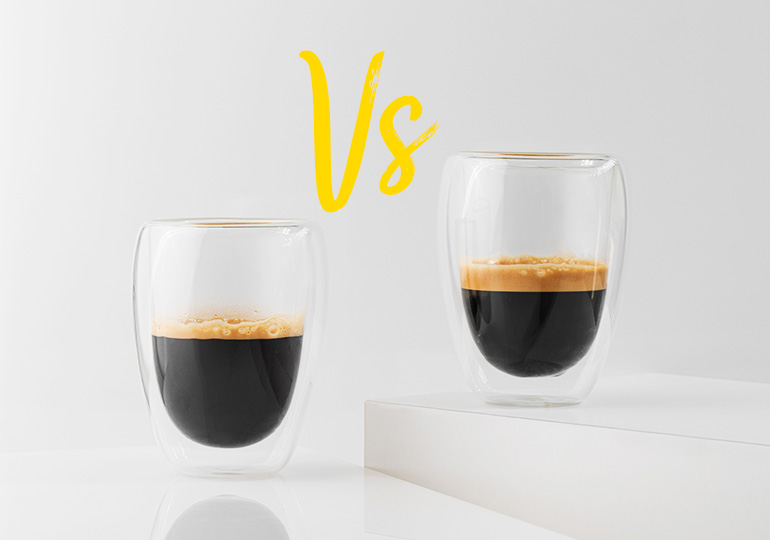
Americano is tastier than lungo. Why is that? As we’ve already mentioned, when espresso is brewed, the coffee is extracted to the fullest, until it has nothing more to give. On the contrary, during the preparation of lungo, the process of extraction keeps on going, resulting in the bad characteristics of the ground coffee seeping into the drink too. If you choose to brew a portion of espresso and dilute it with some hot water instead, you’ll end up preserving the best qualities of your coffee, while the added water will provide the drink with some extra sweetness — no unwanted, unpleasant flavours involved.
Milk-Based Drinks: Cappuccino and Latte
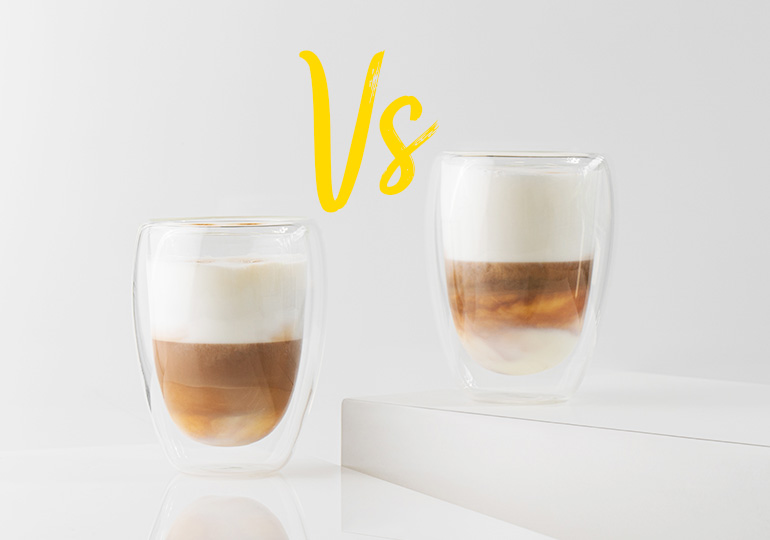
How to brew a gorgeous milk-based coffee drink? First, you’ll have to learn the difference between latte and cappuccino. You already know that the base of both of these beverages consists of espresso — because it’s so thick, you can see it on the inner walls of the cup once you twirl it around gently. The key difference between the two drinks lies in the quantity of milk and in the way it’s frothed.
A cup of cappuccino consists of ⅓ of espresso, ⅓ of milk and ⅓ of milk foam, while latte is comprised of espresso, nearly a whole cup of warm milk, as well as an upper layer of smooth, creamy milk foam, the thickness of which should be a tad over 1 centimetre. The technique involved in the preparation of both of these beverages is identical, but it’s evident from the recipes that cappuccino requires a larger quantity of milk foam.
How to Froth Milk for a Cup of Cappuccino or Latte?

Before you immerse the steamer in a milk frothing jug, release some steam into a napkin to get rid of the condensate. Then use your left hand to grip the bottom of the jug and put the steamer in it in a way that would allow the steamer to rest against the spout and froth milk without sliding from one side to the other.
Once you’re sure that the steamer is upright and all of its holes are immersed in the milk, use your right hand to quickly release the steam in full force. As soon as you do that, lower the jug a bit. The holes of the steamer should then touch the surface of the milk and you should be hearing a continuous “tshhhh” sound. If that’s exactly what’s going on, hurray — you’re now frothing milk foam!
This is when you must decide whether the foam is meant for a cup of latte or cappuccino. If it’s the former, froth milk in this way for up to 3 seconds, and if it’s the latter, the frothing duration should be no longer than 5 seconds. Once the time is up, change the angle of the jug slightly so that the steamer is askew somewhat rather than upright. While you do that, make sure that its holes remain immersed in the milk.
If you do everything correctly, a whirlpool will form in the centre of the milk — it’ll slowly draw in and eliminate all bubbles. During this stage, milk foam is mixed with warm milk. Once you’ve mastered this technique, you’ll be able to prepare milk that is as smooth as silk and as light as a cloud.
Froth milk for your cappuccino until it reaches 65 °C (you can use a thermometer at first to be sure of the temperature). This temperature allows the lactose in the milk to unveil all of its natural sweetness, so the drink will need no sugar even if you’re used to sweetening your coffee all the time.
For a cup of latte, heat milk until it reaches 70 °C. This will help ensure that the milk will stay warm for longer and even the very last sip, flooding your palate with its incredible warmth, will make you gasp with pleasure.
At the very end of this process, turn off the steam with a sudden movement (do this with your left hand, the one that you’ve previously used to grip the bottom of the jug — your right hand should now be used to hold the handle of the jug). Put the jug aside and clean the steamer with a napkin. Make sure to release a bit of steam as well to get rid of the milk left inside the steamer.
Let the milk rest for 15 seconds, then grip the handle of the jug and twirl the milk anti-clockwise until the foam acquires a glossy look.
If you’re making a cup of latte, use the spout of the jug to pour the milk in a thin stream, but if you’re preparing cappuccino, transfer the milk to the cup over the edge of the jug with the help of a sudden movement so that all of the foam plops into the cup.
When it comes to milk-based coffee drinks, flat white and espresso macchiato are also extremely popular. For the first recipe, skip the process of frothing and simply pour steamed milk into the cup like you would if you were making latte. For the second recipe, prepare milk foam using the cappuccino technique and put 4–5 spoonfuls of it onto a portion of espresso.
Last but not least, don’t forget that each of these drinks should be enjoyed immediately after preparation — that’s when they’re the tastiest!
Maintenance of a Semi-Automatic Coffee Machine

Daily. Make sure to always rinse the coffee brewing group in between drinks by dispensing a small quantity of water, and clean the portafilter thoroughly after throwing out the coffee grounds. You should also clean the steamer with a cloth immediately after use. Don’t forget to wash the drip tray and the cup grate once you’re finished making coffee for the day as well!
Once a week or once every 100 coffee portions. Using a special cleaning tablet, perform the coffee brewing group and portafilter cleaning program (some semi-automatic coffee machines have a special “blind” filter for this purpose). This program will help you get rid of coffee residues and oils. You can also dissolve the cleaning tablet in water, put the portafilter and the coffee filters in it, let them soak for at least 15–30 minutes, then rinse them thoroughly using clean water.
As required. If your coffee machine is equipped with a built-in grinder, don’t forget to clean it using special coffee grinder cleaning tablets from time to time.
Descaling your coffee machine: if your machine is equipped with the thermoblock heating system, you must regularly perform the descaling program based on the instructions in the user manual. However, if your appliance has a built-in boiler (or boilers), we highly recommend using additional water filters or soft water — this is because both regular descaling programs and limescale itself may cause harm to these machines. If limescale has built up and you’ve started experiencing problems because of this, we encourage you to contact coffee machine service technicians.
The Most Popular Domestic Espresso Machines
To make choosing the right espresso machine a whole lot easier, we’ve listed the best and most popular semi-automatic espresso machine models currently on the market. We’ve grouped these appliances according to their price, so you can make your choice based not only on the machine’s technical specifications, but also on your budget. Detailed descriptions of each of these models will help you out even further.
The Best Espresso Machines: up to 300 £
| Technical specifications | De’Longhi „EC230.BK | De’Longhi „EC251.W“ | De’Longhi „EC685.M“ |
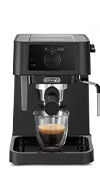 |
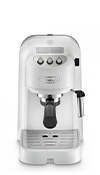 |
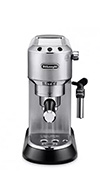 |
|
| General characteristics | |||
| Manufacturer | De’Longhi | De’Longhi | De’Longhi |
| Country of origin | China | China | China |
| Power | 1100 W | 1100 W | 1300 W |
| Water pump pressure | 15 BAR | 15 BAR | 15 BAR |
| Manometer | No | No | No |
| Steamer type | Narrow tube | Wide tube | Wide tube with two positions (for frothed and non-frothed milk) |
| Separate hot water nozzle | No | No | No |
| Built-in grinder | No | No | No |
| Operation | |||
| Screen | No | No | No |
| Operation type | Rotary switch | Buttons | Programmable buttons |
| Settings | |||
| Programmable portion size | No | No | Yes |
| Temperature settings | No | No | Yes |
| Other features | – | Possibility of brewing drinks from coffee pods | Possibility of brewing drinks from coffee pods; possibility of adjusting water temperature; integrated descaling program and programmable water hardness |
| Tanks | |||
| Water tank | 1 l | 1,1 l | 1,1 l |
| Dimensions and weight | |||
| Coffee machine dimensions (width x height x depth) | 20,5 cm x 28,5 cm x 34,3 cm | 20,8 cm x 32,7 cm x 32 cm | 14,9 cm x 30,3 cm x 33 cm |
| Weight | 4,3 kg | 3 kg | 4,2 kg |
| Portafilter size (mm) | 51 mm | 51 mm | 51 mm |
| Included in the set | |||
| Included in the set | Single filter, double filter, plastic scoop/tamper for ground coffee | Single pressurised filter, double pressurised filter, plastic scoop/tamper for ground coffee | Single pressurised filter, double pressurised filter, coffee pod filter, plastic scoop/tamper for ground coffee |
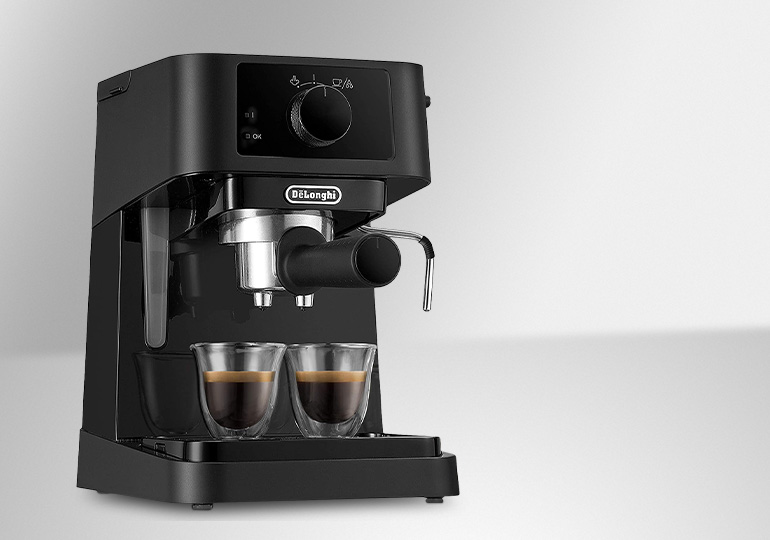
Espresso machine De’Longhi „EC230.BK“
One of the cheapest and most popular espresso machines out there, this model is sure to meet the needs of a coffee brewing novice. It’ll allow you to easily brew one or two portions of espresso or black coffee, as well as to froth milk for your favourite milk-based drinks.
The appliance is very easy to operate: simply use the rotary switch located on the front of the machine. Turn it to one side and steam will be released, turn it to the other and the appliance will start brewing coffee. Inside this model, there’s a small, yet sturdy, stainless-steel boiler that is extremely durable and long-lasting.
Another important feature is the possibility of using taller cups or glasses. The bottom cup tray is removable, so you can choose cups that are up to 11-cm-high. Moreover, this coffee machine has a particularly stylish look — it’s bound to adorn any interior.
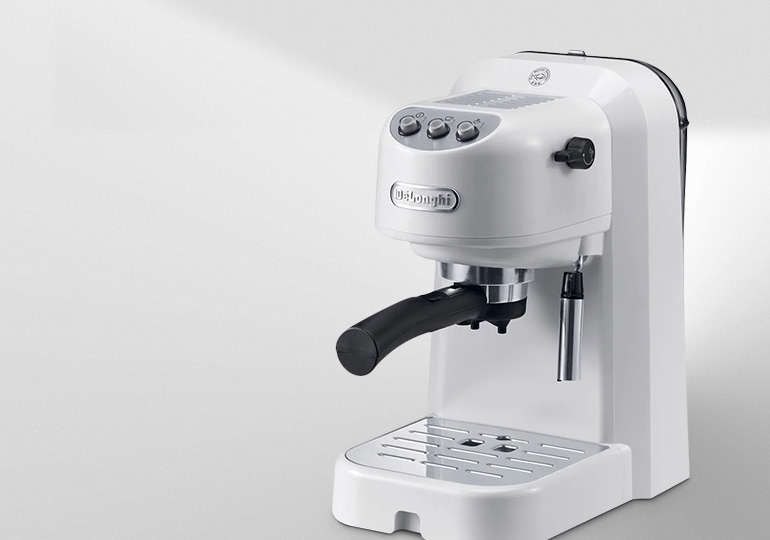
Espresso machine De’Longhi „EC251.W“
This model is also well-liked amongst coffee lovers on a budget. Even though it’s a tad older than the first one, it’s still extremely popular. Unlike the first model, this machine is operated with the help of three buttons located on the front panel of the appliance: there’s an ON/OFF button, a coffee button and a steam button.
The key difference between the two is probably the fact that the “EC251.W” is equipped with pressurised filters (we’ve discussed them in the first part of the article). Thanks to the pressure created by the double bottom layer of these filters, your espresso will be coated with particularly stiff, thick crema — even if the beans haven’t exactly been ground perfectly. The steamer of this model is shaped a little bit differently, so beginners can froth milk foam with more ease.
Another serious advantage is the possibility of brewing drinks with the help of coffee pods, as well as ground coffee (this is why the machine is marked with the acronym E.S.E. — Easy Serving Espresso). Keep in mind though that this model only accommodates shorter cups that are no higher than 8.6 cm.
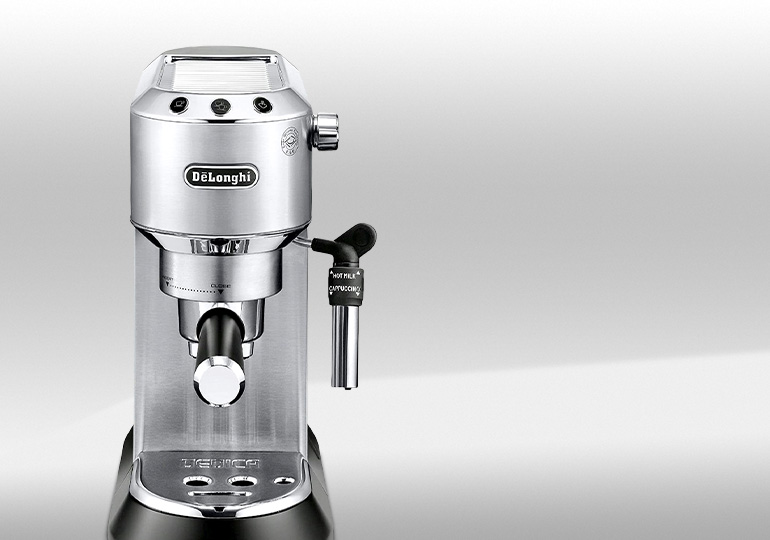
Espresso machine De’Longhi „EC685.M“
This machine is the undisputed leader of the price category at hand. Why is that? Well, first of all, its metallised body and stylish design make this coffee machine look extremely modern, so it’s guaranteed to suit any interior.
Just as important is the fact that this model is extremely narrow (it’s as little as 14.9-cm-wide!), so any kitchen will have enough space for it. As far as the operation of this machine is concerned, it’s equipped with programmable buttons for one or two portions. Moreover, the model lets you adjust water temperature (you can choose from three different levels), which means that you can experiment with various coffee flavours.
It’s evident from the picture of this coffee machine that its steamer differs a bit from the ones found in models we’ve discussed earlier. This steamer has two fixed positions: one lets you prepare hot non-frothed milk, while the other produces milk foam. The appliance can also brew drinks using coffee pods — and, to make it even more convenient, there’s a separate coffee pod filter included. The regular filters of this machine are pressurised, so gorgeous crema is an absolute guarantee!
Programmable water hardness and a built-in signal notifying the user about the need to perform the descaling procedure are also worth mentioning. The combination of the two makes maintaining the coffee machine a whole lot easier. Given all of the above, it’s no surprise that this model has been at the forefront of this price category for several years now.
The Best Espresso Machines: 500 – 700 £
| Technical specifications | Sage „The Barista Express SES875“ | Anita PL042TEMD“ | Rancilio „Silvia E“ |
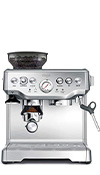 |
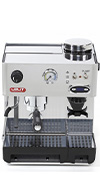 |
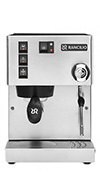 |
|
| General characteristics | |||
| Manufacturer | Sage | Lelit | Rancilio |
| Country of origin | China | Italy | Italy |
| Power | 1850 W | 1000 W | 950 W |
| Water pump pressure | 15 BAR | 15 BAR | 15 BAR |
| Manometer | Yes | Yes | No |
| Water heating system | Thermocoil with the PID system | Boiler (250 ml) + PID system | Boiler (300 ml) |
| Steamer type | Professional steamer | Professional steamer | Professional steamer |
| Separate hot water nozzle | Yes | No | No |
| Built-in grinder | Yes | Yes | No |
| Operation | |||
| Screen | No | No | No |
| Operation type | Programmable buttons | Levers | Buttons |
| Settings | |||
| Programmable portion size | Yes | No | No |
| Temperature settings | Yes | Yes | No |
| Other features | Integrated removable tamper | Integrated tamper |
– |
| Tanks | |||
| Water tank | 2 l | 2,7 l | 2 l |
| Dimensions and weight | |||
| Coffee machine dimensions (width x height x depth) | 33 cm x 40 cm x 31 cm | 31.5 cm x 36.8 cm x 25.5 cm | 23.5 cm x 34 cm x 29 cm |
| Weight | 12 kg | 10.2 kg | 14 kg |
| Portafilter size (mm) | 54 mm | 57 mm | 58 mm |
| Included in the set | |||
| Included in the set | Dosing tool “Razor”, single and double filters (pressurised and non-pressurised), coffee scoop, integrated tamper, stainless-steel milk frothing jug, cleaning disc and tablets, cleaning brush and other tools, water filter holder and water filter | Single and double filters, coffee pod filter | Single and double filters, ground coffee scoop, stainless-steel tamper |
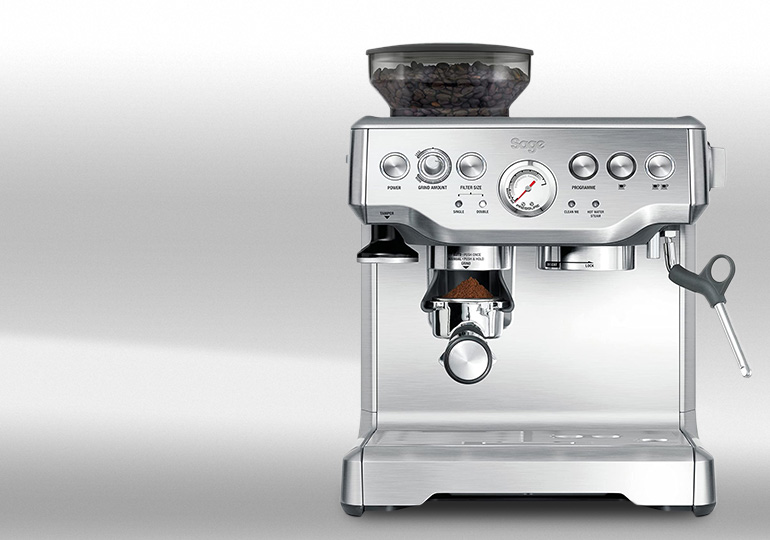
Espresso machine SAGE „The Barista Express SES875“
This espresso machine with a built-in coffee grinder and a myriad of accessories (just look at the list in the table above!) will make you feel like a true home barista! You’ll be able to grind beans in just the right way and have the ground coffee poured straight into the portafilter (its size is not exactly professional yet, but it’s almost there).
Using the integrated tamper, you’ll tamp your coffee properly and insert it straight into the machine. The model boasts a thermocoil heating system with a built-in digital temperature sensor, otherwise known as the PID system. This means that you’ll be able to adjust the temperature of your coffee and experiment with various coffee flavours. Portion size can be programmed with ease. A high-pressure pump enables you to brew coffee that is extremely creamy and aromatic, while a professional steamer helps you froth milk like a real barista and enjoy restaurant-style coffee at home.
It’s important to mention that the set of this coffee machine includes two types of filters: pressurised and non-pressurised. You’ll be able to give both of them a try and pick the filters that suit you best. There’s no need to worry about finding a high-quality milk jug as well — it’s included in the set too. All in all, this coffee machine is perfect for those who want to feel like true baristas without getting too deep into the subtleties of professional coffee brewing.
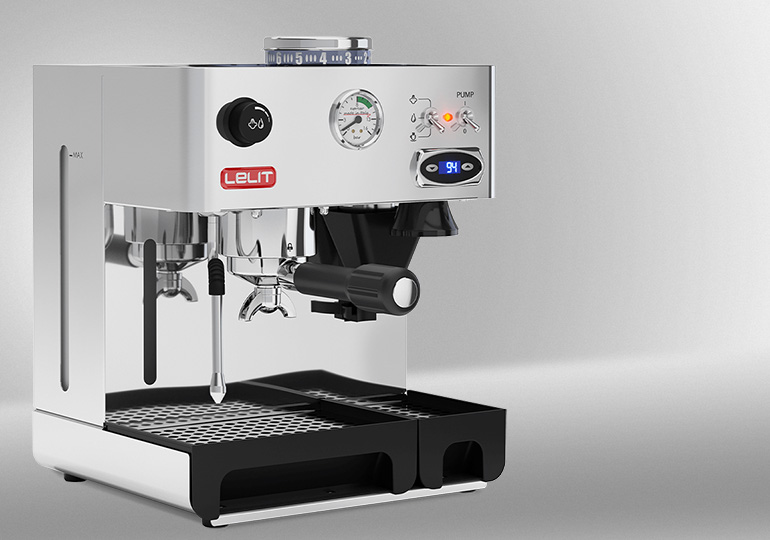
Espresso machine Lelit „Anita PL042 TEMD“
This espresso machine, manufactured in Italy by Lelit, brings us to an even higher level of professionality. Just like the Sage model above, “Anita” is equipped with a built-in grinder, so beans are ground straight into the portafilter prior to each preparation of a drink. The diameter of the portafilter is even closer to the professional standard — it measures 57 mm.
Furthermore, just like the most professional coffee machines out there, this one has a boiler, albeit a small one. It ensures stable and consistent temperature of the water used for coffee brewing. The capacity of the copper boiler is 250 ml. It’s also worth mentioning that this model doesn’t take long to heat up at all — as little as 3 minutes is enough. The PID temperature controller that the boiler is fitted with allows you to adjust the temperature of coffee and steam. In this regard, the possibilities afforded by this machine are even wider than those found in the Sage model. Last but not least, a convenient steamer enables you to froth milk foam for your favourite milk-based drinks with extreme ease.
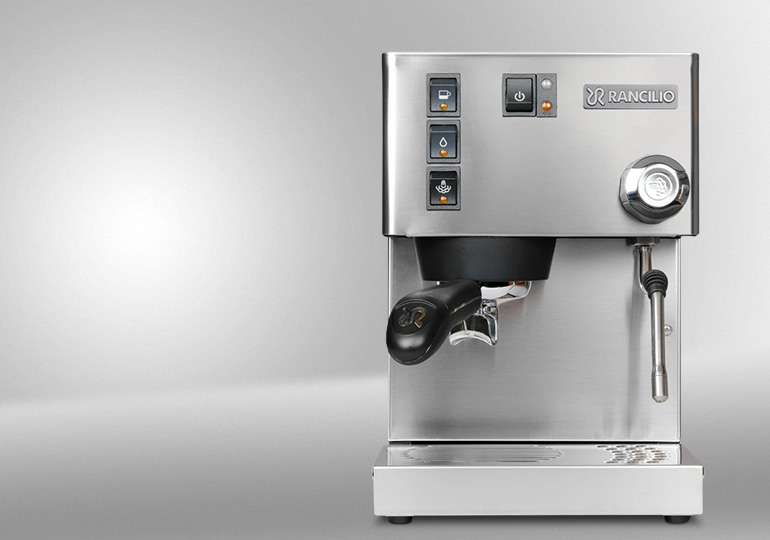
Espresso machine Rancilio „Silvia E“
If you want to take your coffee brewing ritual to a whole new level, we suggest you consider the “Silvia E” model produced by Rancilio, a well-known Italian coffee machine manufacturer. With its high-quality materials and a heavy metal body, every detail found in this appliance is testimony to the extensive experience of the people who brought it into the world.
Inside it, there’s a boiler that is excellent at maintaining the required temperature (just like the ones found in the most professional coffee machines on the market!). The boiler is extremely well insulated, so it’ll help you save energy too. The professional 58-mm portafilter effortlessly slides into the user’s hand and makes both amateurs and true professionals instantly fall in love with it. The steamer, which is professional too, allows you to enjoy the frothing process to the fullest and even try your hand at latte art. The full set of the coffee machine includes a durable professional tamper.
Even though this model isn’t equipped with a built-in grinder (which means you’ll have to purchase it separately), this isn’t necessarily a bad thing. We’ve already mentioned that the more professional an espresso machine is, the lower the chance of it having a built-in coffee grinder.
The Best Espresso Machines: 950 – 1300 £
| Technical specifications | Sage „the Barista™ Touch SES880“ | Ascaso „Steel Duo PID Black&Wood“ | Lelit „MaraX PL62X“ |
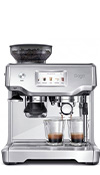 |
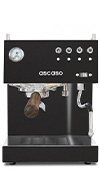 |
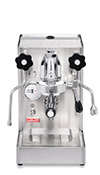 |
|
| General characteristics | |||
| Manufacturer | Sage | Ascaso | Lelit |
| Country of origin | China | Spain | Italy |
| Power | 2400 W | 2068 W | 1400 W |
| Water pump pressure | 15 BAR | 20 BAR | 15 BAR |
| Manometer | No | Yes | Yes |
| Water heating system | Thermocoil with the PID system | Thermoblock with the PID system | Stainless-steel HX boiler (1.8 l) with the PID system |
| Steamer type | Automated steamer | Professional steamer | Professional steamer |
| Separate hot water nozzle | Yes | Yes | Yes |
| Built-in grinder | Yes | No | No |
| Operation | |||
| Screen | Colour touch screen | No | No |
| Operation type | Touch-sensitive | Lever switches | Lever and handles |
| Settings | |||
| Programmable portion size | Yes | Yes | No |
| Temperature settings | Yes | Yes | Yes |
| Other features | Automated milk frothing and other automated processes, possibility to save recipes | Professional portafilter and steamer, programmable pre-brewing | E61 group head, possibility to froth milk and brew coffee simultaneously |
| Tanks/container | |||
| Water tank | 2 l | 2 l | 2,5 l |
| Boiler capacity |
– | – | 1,8 l |
| Dimensions and weight | |||
| Coffee machine dimensions (width x height x depth) | 32,2 cm x 40,7 cm x 32,2 cm | 27 cm x 36 cm x 31.5 cm | 22 cm x 35 cm x 41 cm |
| Weight | 20 kg | 12 kg | 18.8 kg |
| Portafilter size (mm) | 54 mm | 58 mm | 58 mm |
| Included in the set | |||
| Included in the set | Stainless-steel milk jug, cleaning discs and tablets, double-walled filters, single-walled filters, water filter and holder, cleaning brush, dosing tool “Razor”, hex key, steamer cleaning tool, water hardness test, tamper | Wooden portafilter (with a diameter of 58 mm), 5 stainless-steel filters: 2 non-pressurised filters (single and double), 2 pressurised filters (single and double) and 1 coffee pod (E.S.E.) filter, professional aluminum tamper, filter for cleaning the group head | 58-mm commercial-grade portafilter, 4 filters: 9–11 g, 14–18 g, 18–21 g and one “blind” cleaning filter, raised stand for espresso cups, water filter, 58-mm stainless-steel tamper with a wooden handle |
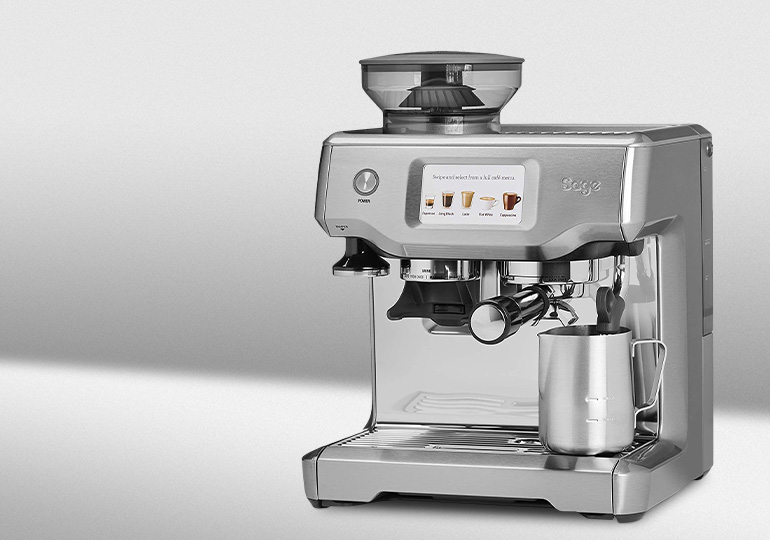
Espresso machine Sage „the Barista™ Touch SES880“
This coffee machine must be what every coffee-brewing novice is dreaming about! Even though it belongs to the category of semi-automatic espresso machines, this model is like your own personal barista. The processes are fully automated: all you have to do is follow the instructions or change the settings using a touch-sensitive colour screen.
You’ll find as many as 5 pre-programmed beverages in the machine. Pressing one of the available recipes will allow you to view the settings that you can adjust: they include grinding duration (the model is equipped with a built-in coffee grinder), coffee brewing temperature and time, and even the milk frothing level. When frothing milk, you’ll have to immerse the automated steamer in the milk and that’s it — the tool will froth barista-worthy foam all by itself. The innovative heating system allows the machine to heat up extremely quickly and brew one cup after the other with no breaks in between. The built-in PID temperature controller lets the users adjust the temperature as they see fit and play around with various coffee flavours. You can even create and save 6 additional recipes of your own!
This coffee machine is a great choice for those who want to enjoy delicious drinks quickly and conveniently while transferring some of the responsibility involved in coffee brewing onto the machine itself. Don’t forget to take a look at the list of accessories included in the full set too — it’s truly impressive!
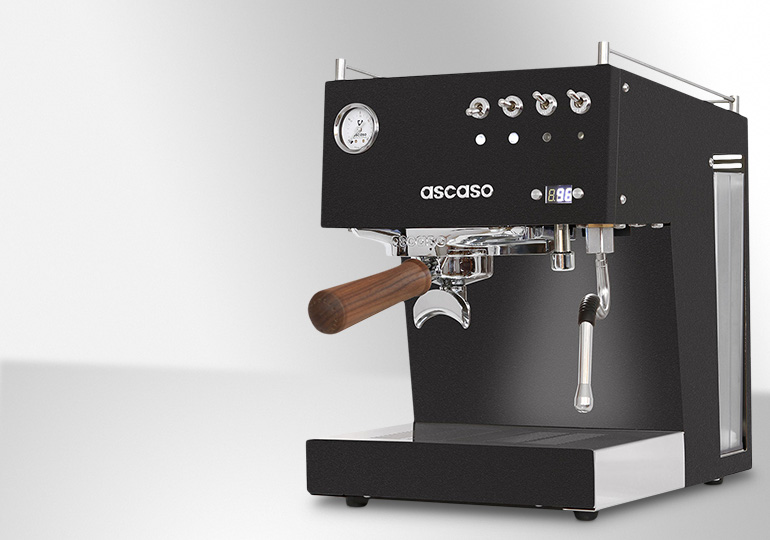
Espresso machine Ascaso „Steel Duo PID Black&Wood“
If you’re someone who enjoys doing things by hand, dreams about being the traditional barista and values the design and beauty of a coffee machine no less than they value its functionality, this appliance is definitely for you!
One of the features of this machine is a 58-mm portafilter, which is typical of professional appliances of this kind. The handle of the portafilter is made of wood (which lends it a feel of luxury and makes it pleasant to the touch) and characterised by an angle that helps the tool stand evenly on a working surface, so you can tamp your coffee in the exact right way.
Another important feature is a steamer with heat-resistant coating. You can safely touch it even during the frothing process. We can state with confidence that it’s simply perfect for latte art too. The coffee machine is equipped with two separate heating systems: one for steam and one for coffee brewing (this system is called “dual thermoblock”). The systems ensure that the temperature required for both steam and coffee is reached extremely quickly. In addition, there’s no need for breaks in between the coffee brewing and the milk frothing.
When it comes to the former, the programmable and adjustable pre-brew function and water temperature are bound to come in handy. The cup warming feature has been thought about too — there’s a wide cup warming area on the top of the appliance. Last but not least, the industrial design and the lovely detail of an illuminated water tank add a nice aesthetic touch to the already remarkable whole.
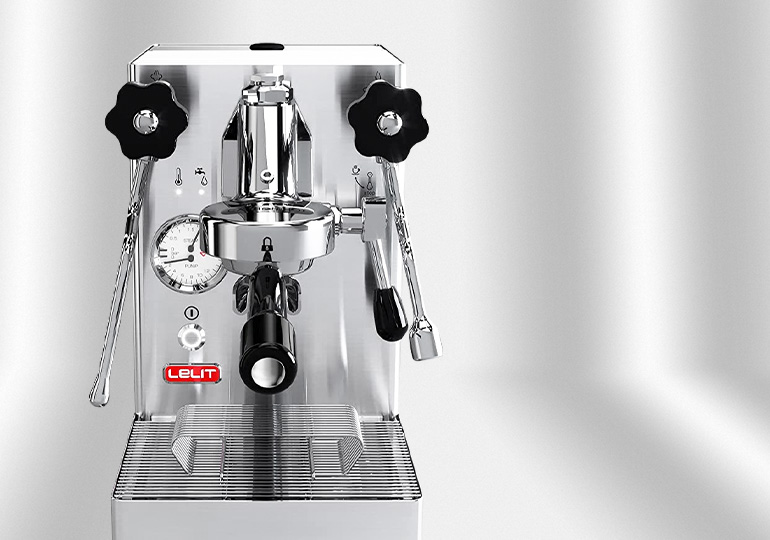
Espresso machine Lelit „MaraX PL62X“
Let’s go even higher up the espresso machine ladder and get closer to the art of coffee brewing in its purest form. This HX coffee machine is equipped with a particularly capacious boiler, a separate coffee brewing system, the traditional E61 brew group and a professional steamer, so it allows you to control the whole coffee preparation process from start to finish.
What’s bound to catch the eye first is the legendary E61 brew group, which ensures the highest level of thermal stability and lets the users brew coffee just the way they like it. Lift the handle up a bit and you’ll turn on the pre-infusion function, then lift it all the way up and monitor the water pressure in the manometer to make sure that it’s just right for coffee brewing. The dispensing duration and the quantity of dispensed coffee cannot be programmed using the E61 group, but this means that you can adapt to the changing situation and stop the dispensing manually whenever you see fit.
While your espresso is being dispensed, you can simultaneously froth some milk for a cup of latte or cappuccino (this is thanks to the HX boiler). Because the steamer of this appliance is particularly powerful, it enables you to froth a larger quantity of milk needed for two portions of coffee all at once.
Ever since you first lay eyes on this extraordinary machine, you’ll fall in love with the art of coffee brewing. This appliance is designed for those who view coffee-making as a craft and are ready to keep on working on every nuance of this process until they nail it to perfection.
The Best Espresso Machines: more than 1500 £
| Technical specifications | Sage „the Oracle™ Touch SES990“ | Rocket Espresso „R Cinquantotto“ | Lelit „Bianca PL162T“ |
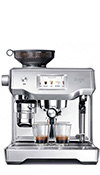 |
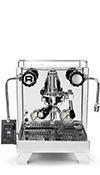 |
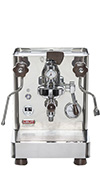 |
|
| General characteristics | |||
| Manufacturer | Sage | Rocket Espresso | Lelit |
| Country of origin | Kinija | Italija | Italija |
| Power | 2400 W | 1400 W | 1400 W |
| Water pump pressure | 15 BAR | 15 BAR | 15 BAR |
| Manometer | No | Yes | Yes |
| Water heating system | Two separate boilers with the PID system | Two separate boilers with the PID system | Two separate boilers with the PID system |
| Steamer type | Automated steamer | Professional steamer | Professional steamer |
| Separate hot water nozzle | Yes | Yes | Yes |
| Built-in grinder | Yes | No | No |
| Operation | |||
| Screen | Touch screen | Separate touch panel | No |
| Operation type | Touch-sensitive | Lever and handles | Lever and handles |
| Settings | |||
| Programmable portion size | Yes | No | No |
| Temperature settings | Yes | Yes | Yes |
| Other features | Fully automated processes: grinding, tamping, brewing, frothing | Professional rotary pump; possibility to connect the appliance to the mains water supply | Possibility to adjust pressure during brewing; possibility to connect the appliance to the mains water supply |
| Tanks/containers | |||
| Water tank | 2,5 l | 2,5 l | 2,5 l |
| Boiler capacity | (Will be added) | 580 ml for coffee and 1.8 l for steam | 800 ml for coffee and 1.5 l for steam |
| Dimensions and weight | |||
| Coffee machine dimensions (width x height x depth) | 37 cm x 41 cm x 45 cm | 31 cm x 38.5 cm x 44 cm | 29 cm x 40 cm x 40 cm |
| Weight | 12 kg | 20 kg | 20 kg |
| Portafilter size (mm) | 58 mm | 58 mm | 58 mm |
| Included in the set | |||
| Included in the set | Stainless-steel milk jug, double filter, single filter, water filter and holder, cleaning discs and tablets, knockbox, cleaning brush for grinder burrs, steamer cleaning powder, water hardness test | (Will be added) | Double and single filters, bottomless portafilter, blind filter, 70-l water filter, stainless-steel tamper with an aluminum handle, brewing group brush, microfiber cloth, additional steamer, accessories for connecting the appliance to the mains water supply |
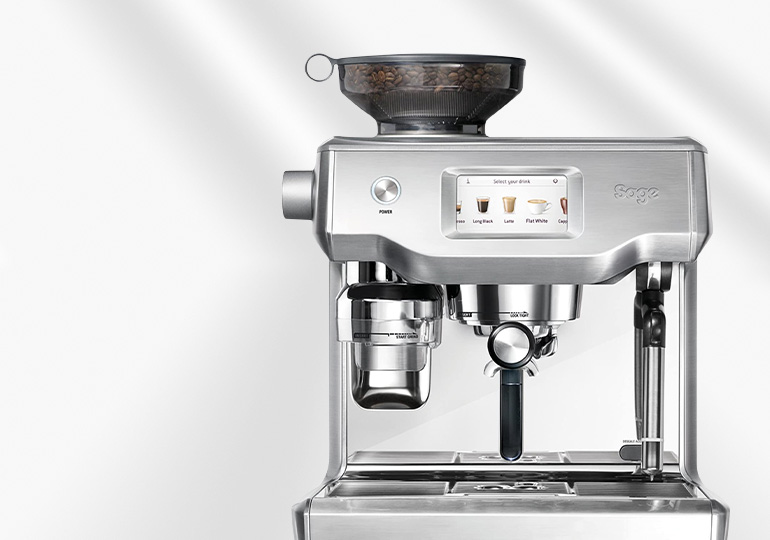
Espresso machine Sage „the Oracle™ Touch SES990“
With this coffee machine produced by Sage, we enter a whole new era of semi-automatic espresso appliances. Equipped with a dual-boiler heating system and a professional 58-mm portafilter that holds as much as 22 grams of coffee, it’s even closer to professional models.
More processes are automated too: not only does this machine froth milk automatically, imitating the actions of a barista and obtaining the perfect result every time, but it also tamps the ground coffee all by itself using a built-in tamper.
The automatic pressure maintenance is probably the most innovative feature of this model though — it means that the pressure of water used for coffee brewing remains stable at all times, hence preserving all of the characteristics of your coffee’s flavour. Amongst the many recipes found in this Sage model, there’s the automatic americano: all you have to do is select the drink and the machine will brew a double espresso before adding water to it with the help of a separate spout. Moreover, it also allows the users to save up to 8 personal recipes.
This coffee machine is perfect for a person who dreams about enjoying high-quality coffee and taking an active part in the process of coffee brewing, yet still wants some steps to be performed automatically.
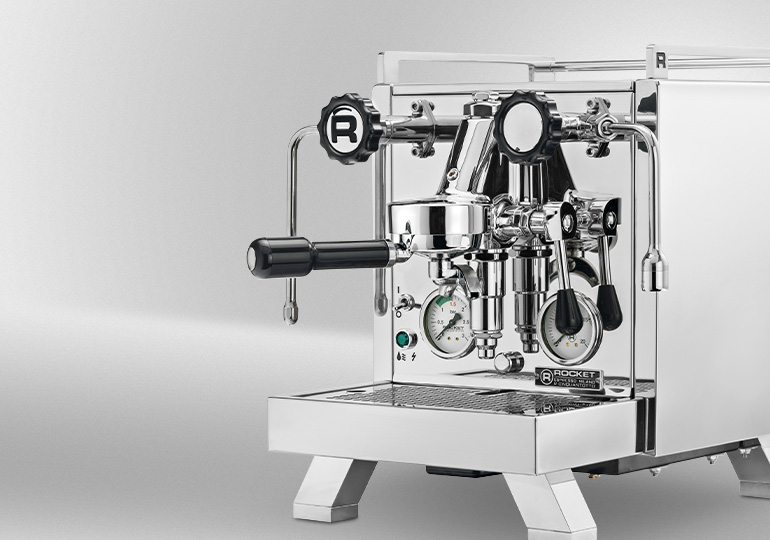
Espresso machine Rocket Espresso „R Cinquantotto“
Rocket Espresso is a well-known manufacturer of commercial-professional coffee machines. It comes as no surprise then that the domestic “R Cinquantotto” model features all of the characteristics typical of professional coffee-brewing appliances.
The rotary pump allows the users to choose the method of water supply that suits them best: they can go for a removable water tank or connect the machine directly to the mains water supply. This is guaranteed to come in handy if the appliance is located in an office and is used to brew multiple drinks in a row. The model is also equipped with two separate boilers, the temperature of which can be adjusted using the integrated PID system.
The touch-sensitive control panel allows you to select the desired functions with ease, yet the presence of the E61 group head means that coffee is dispensed manually. Like other appliances equipped with this group, the “R Cinquantotto” model lets you control the dispensing process with extreme precision and stop it at just the right moment.
The built-in timer is also an excellent addition. It enables coffee lovers to monitor brewing duration and abide by the established norms. All in all, this machine combines the latest technologies with the oldest espresso traditions. It’s the perfect fit for aspiring professional baristas.
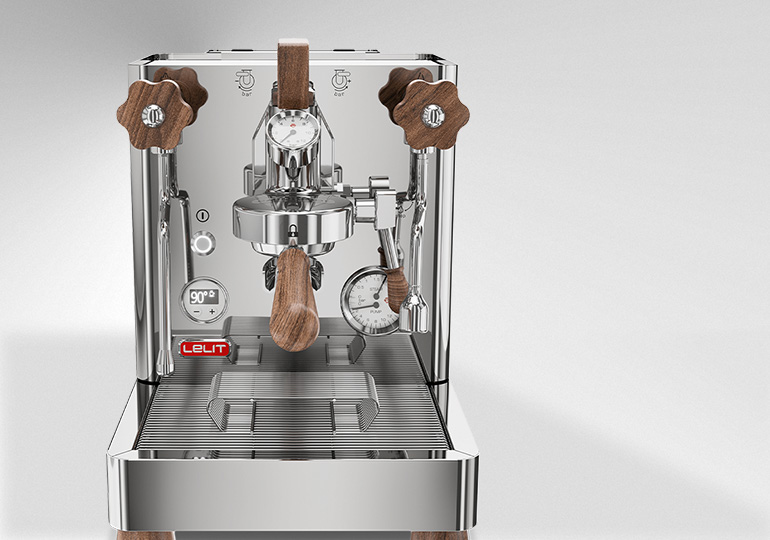
Espresso machine Lelit „Bianca PL162T“
“Bianca” is a true masterpiece produced by the Italian coffee machine manufacturer Lelit. In addition to being equipped with improved features characterising all of the previous models, it completely eliminates the difference between your favourite café and your living room. Adorned with gorgeous wooden details, the “Bianca” model will suit any interior perfectly. The stainless-steel body of this machine is testament to its durability and unflinching readiness to brew multiple cups in a row. Other features found in this appliance are even more unique though.
First of all, there’s a possibility of connecting it straight to the mains water supply, so this espresso machine is suited perfectly not only for domestic use, but also for spaces that require multiple cups of coffee brewed one after the other. As a result, “Bianca” guarantees speedy preparation. But what about the quality of the prepared drinks?
In addition to the E61 group, the PID system, a manometer and a timer, there’s an additional feature that can turn you from a regular passer-by into a true coffee connoisseur. This feature is the pressure adjustment lever. It might sound simple, but genius ideas usually do. The lever allows you to adjust water pressure during the brewing of coffee in real time — and if you maintain the pressure of 9 bar, you’ll preserve all of the best characteristics of your coffee’s flavour.
Sweetness, bitterness, acidity — all of these tastes have never been so vivid and so harmoniously intertwined. This model is guaranteed to be your gateway to the perfect cup of coffee. If you’ve ever wondered whether home-brewed coffee can truly be as good as the one you get in a restaurant, we can now state with confidence: with the help of Lelit “Bianca”, it definitely can!
You can find all of these machines (and more) in our e-shop www.coffeefriend.co.uk. However, if you’re still unsure which type of an appliance is the right fit for you or if you have any questions about a certain model, you’re welcome to contact our consultants. We’d be glad to help you choose the best espresso machine for you!

